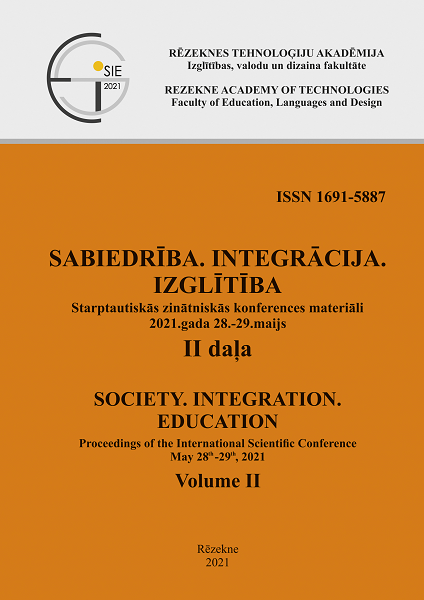HIDDEN POTENTIAL OF CHILDREN’S ART EXHIBITIONS AND THEIR IMPACT ON THE INCREASE IN TEACHER’S SELF-EFFICACY
DOI:
https://doi.org/10.17770/sie2021vol2.6472Keywords:
teacher’s self-efficacy, self-efficacy, children’s art exhibition, pre-school educationAbstract
A key element contributing to the quality of teaching in all educational areas is teacher’s belief in their professional competencies. The paper describes the impact of high or low teacher’s self-efficacy beliefs on the quality of their teaching, as well as the ways to promote self-efficacy. We see a gap in knowledge regarding the issue of whether kindergarten teachers are able to recognise the sources of self-efficacy offered by their practice. The aim of the research was to find out whether teachers can use the potential of children's art exhibitions to strengthen their teacher’s self-efficacy, not only to present children's art works. A qualitative approach has been applied to the research that involved 30 kindergarten teachers awarded for an excellent level of art education. The research has shown that even the most highly qualified teachers benefit from the exhibition in terms of being professionally inspired and motivated. These are mainly self-efficacy supports in the category of vicarious experience and social persuasion. The impact of perceived personal well-being is also very significant. These findings highlight the importance of self-evident activities, such as the presentation and exhibition of children's art works. They can thus serve as a guide in the conception of exhibitions and conscious support for teacher’s self-efficacy.
Downloads
References
Bandura, A. (1986). Social foundations of thought and action: A social cognitive theory. Englewood Cliffs, NJ: Prentice-Hall.
Bandura, A. (1994). Self-efficacy. In V. S. Ramachaudran (Ed.), Encyclopedia of human behaviour, 4, 71–81. New York: Academic Press.
Bandura, A. (1997). Self-efficacy: The exercise of control. New York: W. H. Freeman.
Bandura, A. (2006). Adolescent development from an agentic perspective. In F. Pajares & T. Urdan (Eds.), Self-efficacy beliefs of adolescents (1–44). Connecticut: Information Age
ČŠI. (2014). Národní zpráva šetření TALIS 2013. Praha: Česká školní inspekce. Retrieved from: http://www.csicr.cz/html/TALIS2013-NZ/html5/index.html?&locale=CSY&pn=1
Collins, A. (2016). Generalist pre-service teacher education, self-efficacy and arts education: An impossible expectation? International Journal of Education & the Arts, 17(26). Retrieved from http://www.ijea.org/v17n26/.
Garvis, S. & Pendergast, D. (2010). Supporting novice teachers of the arts. International Journal of Education & the Arts, 11(8). Retrieved from: http://www.ijea.org/v11n8/.
Garvis, S., Twigg, D., & Pendergast, D. (2011). Breaking the negative cycle: the formation of self-efficacy beliefs in the arts. A focus on professional experience in pre-service teacher education. Australasian Journal of Early Childhood, 36(2), 36–41.
Gavora, P. (2010). Úvod do pedagogického výzkumu. Brno: Paido.
Hendl, J. (2005). Kvalitativní výzkum: základní metody a aplikace. Praha: Portál.
Housego, B.E. (1990). A comparative study of student teachers' feelings of preparedness to teach. Alberta Journal of Educational Research, 36(3), 223–239.
Janík, T. (2009). Didaktické znalosti obsahu a jejich význam pro oborové didaktiky, tvorbu kurikula a učitelské vzdělávání. Brno: Paido.
Lemon, N., & Garvis, S. (2013). What is the role of the arts in a primary school? An investigation of perceptions of pre-service teachers in Australia. Australian Journal of Teacher Education, 38(9), 1–9.
Lummis, G., Morris, J., & Paolino, A. (2014). An Investigation of Western Australian Pre-Service Primary Teachers' Experiences and Self-Efficacy in The Arts. Australian Journal of Teacher Education. 39(5), 49-64.
Manning, M., Garvis, S., Fleming, C., & Wong, G. T. W. (2017). The relationship between teacher qualification and the quality of the early childhood education and care environment. Campbell Systematic Reviews, 13(1), 1–82. DOI: https://doi.org/10.4073/csr.2017.1
Maňák, J., Janík, T. & Švec, V. (2008). Kurikulum v současné škole. Brno: Masarykova univerzita.
Miovský, M. (2006). Kvalitativní přístup a metody v psychologickém výzkumu. Praha: Grada Publishing.
MŠ Kampanova. (n.d.). Školka plná dětí- MŠ Kampanova. Retrieved from
https://www.mskampanova.cz/vytvarna-soutez/skolka-plna-deti-2020/
Oreck, B. (2006). Artistic choice: A study of teachers who use the arts in the classroom. International Journal of Education & the Arts, 7(8), 1–26.
Pajares, F. (2005). Self-Efficacy Beliefs of Adolescents. Information Age Publishing, 339–367.
Pajares, F. (2006). Self-efficacy during childhood and adolescence. Implications for teachers and parents. In: Pajares, F. & T. Urdan (Eds.), Self-efficacy beliefs of adolescents (339–367). Greenwich, CT: Information Age Publishing.
RVP PV. (2018). Rámcový vzdělávací program pro předškolní vzdělávání. Praha: MŠMT. Retrieved from https://www.msmt.cz/file/45304/
RVP ZV. (2017). Rámcový vzdělávací program pro základní vzdělávání. Praha: Výzkumný ústav pedagogický. Retrieved from http://www.vuppraha.cz/wp-content/uploads/2009/12/RVPZV_2007-07.pdf>.
Shulman, L.S. (1987). Knowledge and teaching. Foundations of the New Reform. Harvard Educational Rewiew, 57(1), 1–22.
Skaalvik, E., & Skaalvik, S. (2010). Teacher self-efficacy and teacher burnout: A study of relations. Teaching and Teacher Education, 26(4), 1059–1069. 10.1016/j.tate.2009.11.001.
Štěpánková, K. (2019). Kvalita ve výtvarné výchově z pohledu studentů- výzkumná sonda. In: Pospíšil, A., Řepa,K. & P. Šobáňová (Eds.), Kvalita ve výtvarné výchově. Olomouc: Česká sekce INSEA, (69-85).
Štěpánková, K., Píšová, M., & Slavíková, V. (2016). Student’s implicit theories about quality at the art education. Ad Alta: Journal of interdisciplinary research, 6(2), 116–119. Hradec Králové: Magnanimitas.
Tschannen-Moran, M., Hoy, A. W., & Hoy, W. K. (1998). Teachers efficacy: Its meaning and measure. Review of Educational Research, 68(2), 202–248.


